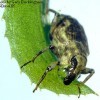Abstract
Bagous hydrillae O’Brien is a semi-aquatic weevil that feeds on the aquatic invasive weed Hydrilla verticillata (L.f.) Royle. Larvae of the weevil mine hydrilla stems and the adults feed on the stems and submerged leaves. This weevil was discovered during overseas surveys for biological control agents for hydrilla during the 1980s and was first introduced to the U.S. in Florida in 1991 after extensive host-specificity testing. This 5-page fact sheet was written by Emma Weeks, Jim Cuda, and Michael J. Grodowitz, and published by the UF Department of Entomology and Nematology, June 2014.
EENY594/IN1036: Hydrilla Stem Weevil Bagous hydrillae O'Brien (ufl.edu)
References
Balciunas JK, Purcell MF. 1991. Distribution and biology of a new Bagous weevil (Coleoptera: Curculionidae) which feeds on the aquatic weed Hydrilla verticillata. Journal of the Australian Entomological Society 30: 333-338. https://doi.org/10.1111/j.1440-6055.1991.tb00448.x
Balciunas JK, Burrows DW, Purcell MF. 1996. Comparison of the physiological and realized host-ranges of a biological control agent from Australia for the control of the aquatic weed, Hydrilla verticillata. Biological Control 7: 148-158. https://doi.org/10.1006/bcon.1996.0078
Balciunas JK, Grodowitz MJ, Cofrancesco, AF, Shearer JF. 2003. Hydrilla. In Van Driesche R et al. 2002 Biological Control of Invasive Plants in the Eastern United States, USDA Forest Service Publication FHTET-2002-04, 413P. (12 April 2014).
Buckingham GR, Balciunas JK. 1994. Biological studies of Bagous hydrillae. Technical Report A-9496 U.S. Army Corps of Engineers, Waterways Experiment Station, Vicksburg, MS.
Buckingham GR, Bennett CA. 1994. Biological and host range studies with Bagous affinis, an Indian weevil that destroys hydrilla tubers. Technical Report A-948 U.S. Army Corps of Engineers, Waterways Experiment Station, Vicksburg, MS.
Center TD, Parys K, Grodowitz M, Wheeler GS, Dray FA, O'Brien CW, Johnson S, Cofrancesco A. 2013. Evidence of establishment of Bagous hydrillae (Coleoptera: Curculionidae), a biological control agent of Hydrilla verticillata (Hydrocharitales: Hydrocharitaceae) in North America? Florida Entomologist 96: 180-186. https://doi.org/10.1653/024.096.0124
Cofrancesco A, Grodowitz M, Center T, Balciunas J. 2005. - Hydrilla stem weevil. Noxious and Nuisance Plant Management Information Systems, Engineer Research and Development Center. (10 April 2014).
Cuda JP, Frank JH. 2013. Florida's established arthropod weed biological control agents and their targets. University of Florida IFAS Electronic Data Information Source. (14 May 2014). https://doi.org/10.32473/edis-in779-2012
Gosik R. 2009. Description of the mature larva and pupa of Bagous lutulentus (Gyllenhal), with comments on its biology (Coleoptera: Curculionidae). Genus 20: 125-135.
Grodowitz J, Center T, Snoddy E. 1995. Current status of use of insect biocontrol agents for the management of hydrilla. Pages 134-141 In Proceedings of the 29th Annual Meeting of Aquatic Plant Control Research Program, 14-17 November 1994, Vicksburg, Mississippi, Miscellaneous paper A-93-2, U.S. Army Engineer Waterways Experiment Station, Vicksburg, Mississippi.
Marvaldi AE. 2003. Key to the larvae of the South American subfamilies of weevils (Coleoptera, Curculionoidea). Revista Chilena de Historia Natural 76: 603-612. https://doi.org/10.4067/S0716-078X2003000400005
O'Brien CW, Askevold IS. 1992. Systematics and evolution of weevils of the genus Bagous Germar (Coleoptera: Curculionidae), I. Species of Australia. Transactions of the American Entomological Society 118: 331-452.
Parys KA, Johnson SJ. 2011. Collecting insects associated with wetland vegetation: an improved design for a floating pitfall trap. The Coleopterists Bulletin 65: 341-344. https://doi.org/10.1649/072.065.0403
Wheeler GS, Center TD. 2007a. Hydrilla stems and tubers as hosts for three Bagous species: two introduced biological control agents (Bagous hydrillae and B. affinis) and one native species (B. restrictus). Environmental Entomology 36: 409-415. https://doi.org/10.1093/ee/36.2.409
Wheeler GS, Center TD. 2007b. Growth and development of the biological control agent Bagous hydrillae as influenced by hydrilla (Hydrilla verticillata) stem quality. Biological Control 8: 52-57. https://doi.org/10.1006/bcon.1996.0484

